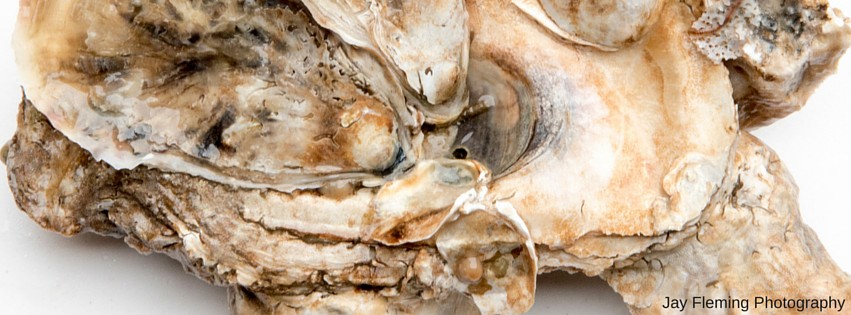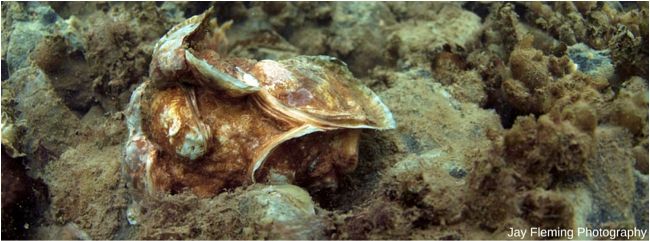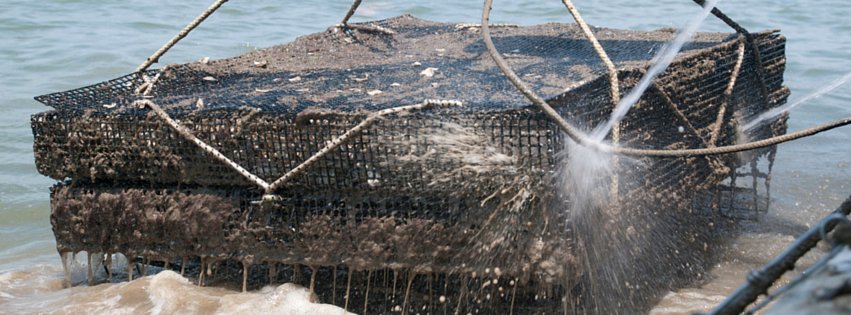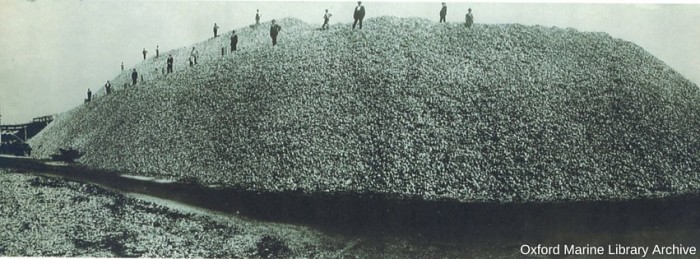
TWELVE NEED-TO-KNOW OYSTER FACTS
1. Etymology
First attested in English during the 14th century, the word “oyster” comes from Old French oistre, in turn from Latin ostrea, the feminine form of ostreum, which is the latinisation of the Greek ὄστρεον (ostreon), “oyster”.
The Greeks envisioned their goddess of love, Aphrodite, springing forth from the sea on an oyster shell and giving birth to Eros, from which the word “aphrodisiac” was born.
2. Varieties
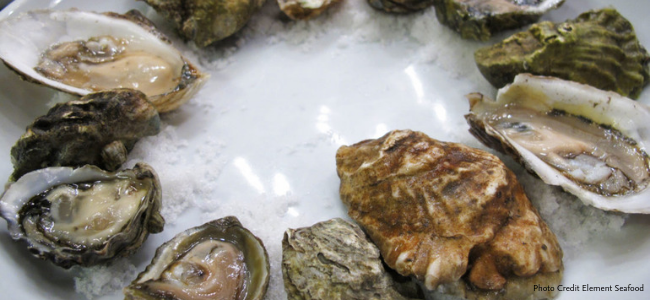
Oysters belong to the phylum Mollusca, which contains many other well-known invertebrates, such as snails, squid, and octopi. Within Mollusca, they reside in the class bilvalvia, which also contains clams and mussels. A defining characteristic of bivalves is two shells hinged together with ligaments. Edible oysters belong to the order Ostreidae and are typically thought of as ‘true oysters’; while additional, non-edible species, referred to as ‘pearl oysters’ or ‘thorny oysters’ belong to different orders. To learn more about taxonomic classification system and the terms phylum, class and order, click here.
Oysters have high phenotypic plasticity, which means that the same species may look extremely different when exposed to differing environmental conditions. This characteristic makes it difficult to determine how species of oyster there are worldwide, and estimations are anywhere from 30 to over 100 [4,3]. Because classification of oyster species based on appearance can be so confusing, scientists have recently been using genetic approaches to identify differing species. The Eastern Oyster, Crassostrea virginica, is native to the Chesapeake Bay and can be found from Maine to Texas.
Check out the World Register of Marine Species to explore historical and currently observed species of oysters.
Triploids and DR strains. Are they GMO?
With the aquaculture industry rapidly increasing in the Chesapeake Bay, there has been interest in varieties of oysters that grow more quickly and exhibit resistance to common diseases. Disease resistant oysters are selectively bred for their ability to survive despite disease pressure, and grow more quickly than wild oysters. Triploid, or spawnless oysters, further enhance growth. Triploid oysters have 30 chromosomes, and are a hybridization of 20 and 40 chromosome individuals. With 30 chromosomes rather than 20, triploid oysters have underdeveloped reproductive systems, and are not likely to spawn. Without expending energy on reproduction, triploid oysters have a faster growth rate than wild, diploid oysters. According to USDA, a similar process is used for seedless fruit in the grocery store, and neither are genetically engineered.
3. Anatomy
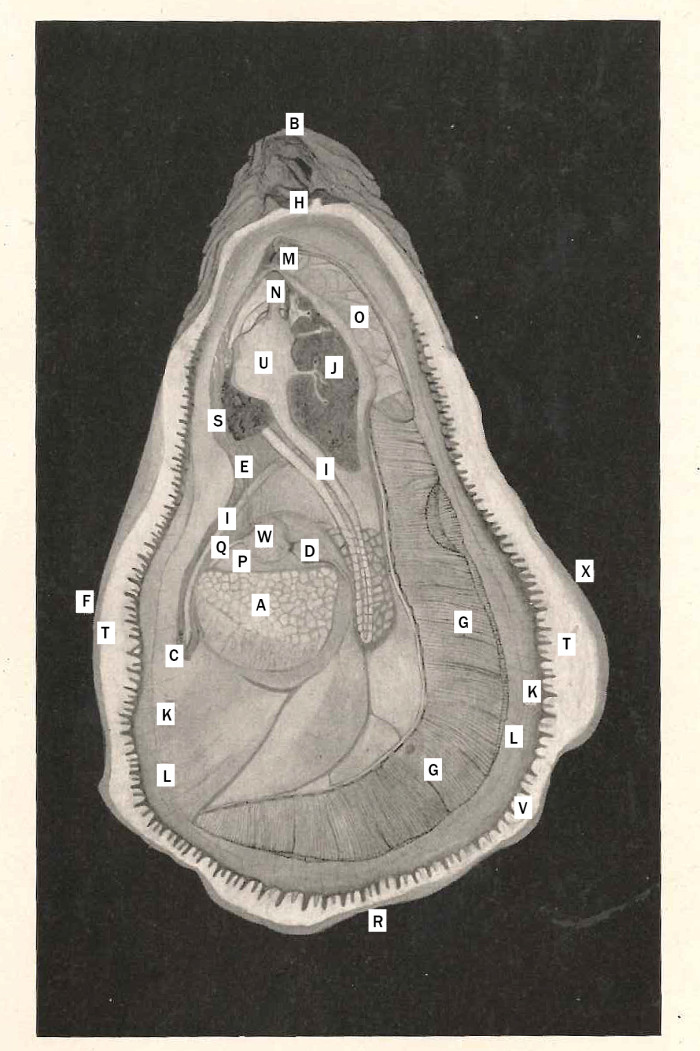
State of Maryland Board of Natural Resources, THE OYSTER, Educational Series, No. 7 (1945)
Semi diagrammatic sketch of an oyster (Dissected in left value).
A. Adductor muscle; B. Anterior end; C. Anus; D. Auricle; E. Anterior aorta; F. Dorsal aspect; G. Gills; H. Hinge ligament; I. Intestine; J. Liver; K. Mantle; L. Nerve; M. Mouth; N. Oesophagus; O. Palps; P. Pericardial cavity; Q. Posterior aorta; R. Posterior end; S. Reproductive glands; T. Shell; U. Stomach; V. Tentacle; W. Ventricle; Z. Ventral aspect.
Oysters have the ability to change sex. The eastern oyster Crassostrea virginica begins its life as a male, but change to female later in life. They are able to change sex in response to environmental conditions or physiological stressors. Studies suggest that the oysters can also change their sex in response to the sex of oysters around them. There is evidence for eastern oysters also being able to change their sex more than once. One study has shown that the switch typically takes place between spawning seasons, when sex organs are undifferentiated.
4. Reproduction
A female oyster is known to produce upward of 100,000,000 eggs in a single season. There is a marked correlation between spawning activities of oysters and the temperature of the water. In the Chesapeake region and through the greater part of the habitat of the species, oysters begin to spawn freely when the temperature reaches about 20 degrees C. Optimum spawning takes place at 24 degrees C while there is an almost complete cessation of spawning when the temperature of the water reaches 28 degrees C. Oysters with ripe gonads can be excited to spawn if, taken from the water ranging about 24 degrees C., the temperature of the water around them is gradually raised to the optimum degree, or slightly about it, and germ cells from the opposite sex are added.
5. Habitat and Behavior
Oyster reefs create a habitat for a multitude of marine life, including two of Maryland’s iconic species, the Blue Crab and Striped Bass.
When oyster larvae (baby oysters) attached themselves to a hard material, like an oyster shell, they are called “spat.” As larvae settle, they receive chemical and environmental cues. If the habitat where larvae settle initially is not suitable, larvae are able to reverse the process and settle elsewhere.
Oysters typically grow up to an inch per year. Usually oysters will grow faster in higher salinity areas than in lower salinity areas.
According to NOAA Fisheries, life span varies greatly depending on tidal height, salinity, disease prevalence and virulence, and predator and parasite prevalence and effectiveness. Oysters usually survive up to several years, but they have lived up to 20 years in captivity.
Predators of juvenile oysters include mud crabs, blue crabs and flatworms. One of the main predators of adult oysters is the cownose ray, Rhinoptera bonasus.
Commonly seen organisms in oyster gardens.
6. Nutrient Cycling and Ecosystem Gardens
Excess nutrients and sediment from human activities negatively affect water quality by disrupting the balance needed to support a healthy ecosystem. Science has shown that oysters can play a role in restoring water quality because of their filter-feeding capabilities.
Oysters remove nutrients from the water by consuming and absorbing the nitrogen and phosphorus from what they eat (algae, for the most part) into their tissue and shells. They then deposit the organic particles making it more accessible to bacteria that convert bioavailable nitrogen to nitrogen gas via denitrification. Oysters also remove sediment particles from the water column during filter-feeding by depositing them on the bottom, which helps clear the water.
7. Diseases
Dermo, caused by the pathogen Perkinsus marinus, was first recorded in the Chesapeake Bay in 1949, and is more prevalent in lower-salinity waters of the Bay. Another disease, MSX (caused by Haplosporidium nelsoni), was first found in the Chesapeake Bay in 1959, two years after it was first found in Delaware Bay. It is more common in higher-salinity waters. MSX probably arrived with the Japanese oyster, Crassostrea gigas, which was intentionally introduced into Delaware Bay to test its growth there (it did not grow well).
Of the two diseases, mortality is generally higher with MSX, which killed most of the oysters larger than 2 inches (51 mm) in higher-salinity waters (>15 psu) when it reached the Bay. Because most of the higher-salinity waters are in Virginia, this had a dramatic effect on the Virginia fishery. Many of the surviving high-salinity oysters recovered in the 1970s with wetter weather and thus lower salinity, which reduces the virulence of MSX as well as Dermo. Wet years tend to have higher oyster survival (because disease intensity is reduced) but lower oyster reproduction (because spawning and settlement require water that has 10-12 psu).
8. Harvest
During the nineteenth century in the United States, various shallow draft sailboat designs were developed for oystering in Chesapeake Bay. These included the bugeye, log canoe, pungy, sharpie and skipjack. During the 1880s, a powerboat called the Chesapeake Bay deadrise was also developed.
9. Aquaculture and Growing Strategies
Oyster aquaculture is a farming practice in which oysters are raised for human consumption.
Three methods of cultivation are commonly used:
- Spat or seed oysters are distributed over existing oyster beds and left to mature naturally
- Spat or seed may be put in racks, bags, or cages which are held above the bottom
- Spat or seed are placed in a cultch within an artificial maturation tank
See a list of Maryland and Virginia oyster farms.
10. History
11. Oysters as Food
While the species is the same, the flavor profile, or merroir, of oysters can differ based on where they are grown. The Chesapeake Bay oyster’s salty-sweet buttery flavor is a reflection of the area’s rich and briny water.
Oysters are low in calories, low in fat and a good source of protein. They are naturally high in many essential vitamins and minerals including iron, omega 3 fatty acids, vitamins A, E, and C, zinc, iron, calcium, selenium, and vitamin B12.
An old myth specifies the best time to eat oysters is during months that contain an “R” (i.e. September through April) and to avoid eating oysters in months that do not contain an “R” (May through August). Today, thanks to modern refrigeration and the development of new breeds of oysters that do not reproduce in the summer, oysters are fine to eat any time.
95% of the oysters we eat are farm raised.
12. Safe Oyster Handling
- All fresh shellfish should be stored in an open container in the refrigerator; do not place them in an airtight container.
- Place a damp towel on top of the oysters.
- Never store shellfish in water. They will die and may spoil.
- Shellfish that are open and don’t close when tapped are dead. Throw them out.
- Storage times for shellfish vary: Shellfish that close their shells completely can be stored for up to seven days. This includes oysters, littlenecks, butter clams, and cockles.
- Shucked Shellfish – Shellfish removed from their shells should keep in a refrigerator for up to three days. In a freezer, they should keep for up to three months.
- Oysters like temperatures of 35-40° F.
- Give oysters a quick rinse before eating to remove any grit.
Want to learn how to shuck an oyster? Let two-time national champion George Hastings teach you!
Hungry? HERE is the full list of Shell Recycling Alliance member restaurants.

